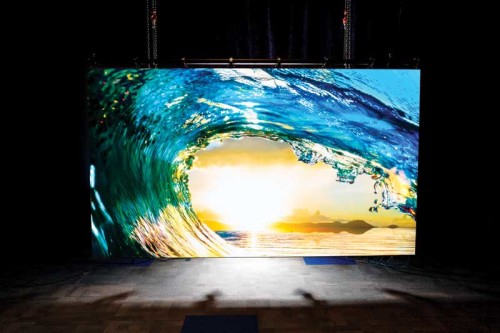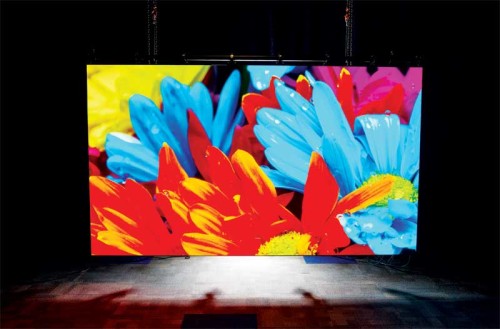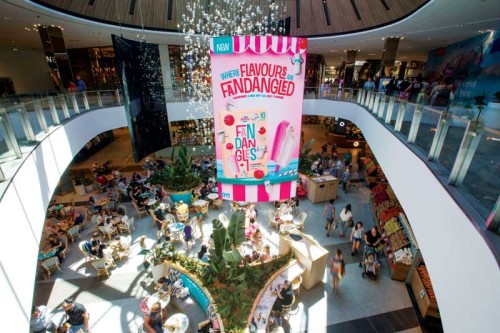Digital Signage: Selecting the right display
by all | 17 February 2016 3:29 pm

Photos courtesy NanoLumens
By Wes Funsch
Today, digital signage is often the first way a business introduces itself to the public. The medium provides a compelling means by which to identify a brand to both potential and existing customers. As such, it can leave a strong—or weak—first impression.
In addition to helping create a memorable customer experience, the return on investment (ROI) for digital signage has improved because of reductions in hardware costs. According to Futuresource Consulting, for example, the $2 billion light-emitting diode (LED) display market is growing by 15 per cent annually, which has helped achieve economies of scale. Citing prices that have “aggressively eroded,” McKinsey & Co. reports the payback time for LED displays will drop to one to two years in 2016.
Before investing in LED displays, however, it is important to understand the options, consider a variety of factors and make an informed decision. Every purchasing process begins with product research that becomes more detailed as the customer’s needs are established and potential vendors are identified. For customers, the entire process from initial research to installation can require anywhere from one month to two years.
Evaluating technologies
Today’s businesses have many choices for their digital signage deployments. Selecting the most appropriate technology will depend on their specific needs and restrictions, along with all of the following criteria:
- Size, shape and weight restrictions for the display space.
- Ambient light in the space.
- Expected viewing distance.
- Ease of content production.
- Budget for energy consumption.
- Allowances for noise and heat generation.
- Desired colour gamut, image resolution and brightness levels.

Display brightness should be specified based on ambient light conditions and expected viewing distances.
If heat restrictions apply to the space where the display will be installed, for example, it will be important to compare models based on the British thermal units (BTUs) they generate.
Screen brightness, meanwhile, is measured in nits, which refer specifically to luminous intensity of a surface in a given direction per unit of projected area. The more ambient light there is in that space, the brighter the display will need to be to ensure high visibility for its audience. The recommended brightness for indoor displays will vary based on the environment, but for outdoor installations operating during daylight hours, displays need to be rated for a minimum of 5,000 nits.
LCDs and video walls
LED-backlit liquid crystal displays (LCDs) are among the most common types of digital displays. Generally, they conform to the native 16:9 aspect ratio format. They are relatively light, thin, efficient and long-lasting. By way of example, a 5.8-m (230-in.) LCD-based video wall may weigh about 454 kg (1,000 lb) without mounting equipment and run for 50,000 to 60,000 hours. LCDs in such a configuration are about 51 to 102 mm (2 to 4 in.) thick, use about 2,800 W, generate about 12,800 BTUs per hour and shine at 400 nits.
The maximum sizes of individual LCDs can hamper attempts to assemble ‘seamless’ video walls. Even so-called zero-bezel LCDs will still show image divisions in a video wall configuration.
Digital projectors
Digital video projection is generally the least expensive option for large-scale display and comes in two forms: rear projection, where images are projected onto the back side of a screen; and front projection, where—like in a movie theatre—the images are instead projected onto a surface from the front. Both forms require very low levels of ambient light to achieve clear image visibility, which is why high-profile projection mapping of buildings and other large outdoor surfaces takes place only at night.
Another primary restriction for video projections is the need for uninterrupted throwing distance, i.e. to keep the space clear between the projector and the projected surface. The size of the display space can help determine whether or not this will be realistic.

Different types of displays provide different colour gamuts.
Also, while this technology may be a relatively cheap way to create gigantic images, the costs of replacing projector bulbs need to be factored in, which could run into the thousands of dollars. Specialized labour may also be required to recalibrate and align multiple projectors for a given project.
Tile displays
Also known as mosaic displays, self-contained non-LCD tiles can be joined modularly to create larger display areas for a highly visually pleasing effect, but can also suffer from visible seams between units. They are twice as heavy as the equivalent LCD panels, due in part to their thickness of 254 mm (10 in.) or greater, which may not be suitable for many spaces.
In further comparison to LCDs, a 5.8-m (230-in.) mosaic will generate about 28,000 BTUs per hour, consume more than 8,000 W, shine at 600 nits and last for about 65,000 hours.
Advanced LED displays
LEDs are essentially small light bulbs, but more efficient and longer-lasting than incandescent bulbs. A higher-quality LED will provide approximately 50,000 to 100,000 hours of illumination, which is equivalent to about five to 11 years of typical use. This has helped today’s advanced LED displays establish a stronger foothold in the digital signage market.
Some LED displays are sufficiently light, thin and flexible to be formed into custom shapes for difficult installation spaces. Similar to LCD-based video walls, a 5.8-m (230-in.) LED-based video wall may weigh about 454 kg (1,000 lb) with a depth of 102 mm (4 in.), yet emit less than 2,000 BTUs per hour, consume only 2,100 W of power, achieve brightness
of 3,000 nits and, as mentioned, last up to 100,000 hours.
Such displays are suitable for both indoor and outdoor use where expected viewing distances are at least 1.5 to 3 m (5 to 10 ft).
Determining TCO
As purchasing a digital display is a major investment for most businesses, cost is just as important a consideration as suitability and performance. The more individual LEDs that are in the display—which depends on how many are in each pixel ‘cluster’—the higher its cost will be. Component costs include those for the mounting hardware, media players (if necessary), cabling and video wall control systems.
The total cost of ownership (TCO) will include not only the purchase of hardware, but also installation, maintenance and ongoing content creation. The labour costs for the installation will vary based on the number of components needed, the level of complexity and the time needed. If the space needs to be adapted to accommodate the display, for example, this may entail adding fixtures such as shades to control ambient light, enhancing wiring connectivity and reinforcing walls. There also may be business downtime for the client during these changes. With video walls and any other installations comprising multiple displays, calibration is essential to ensure consistent, uniform brightness and colour intensity across the entire display area.
Every digital signage system will incur some maintenance costs over time, but higher-quality products will offer a longer lifespan with fewer failures and less need for LED replacements. That said, preventative maintenance also affects TCO. Cooling equipment may be required, depending on the space’s heat restrictions. A stable power supply with strong grounding protection will offset the effects of thunderstorms or other harsh conditions.
Outdoor displays will require periodic cleaning to combat prolonged exposure to wind, dust and rain. Also, front-serviceable displays save on repair time by providing easier access for maintenance teams.

The location will determine display size, shape and weight restrictions.
Content creation software included with a display may involve licensing fees, paid subscriptions and/or training. Some clients prefer to outsource content creation to their digital signage providers, while others will take it in-house; the latter will need easy-to-learn, intuitive software that guides them clearly through the content creation process, provides templates and allows elements to be customized quickly.
Another factor affecting TCO is the warranty, the terms of which can mean the difference between a smart investment and a drain on resources. Without a comprehensive and fair warranty, the customer can incur a higher-than-anticipated TCO.
Manufacturers’ warranty terms for LED displays, for example, will vary based on the length of coverage (the standard is up to three years), the number of failures (i.e. the percentage of LEDs that must fail before the warranty
is executed), the effective date of coverage (i.e. after shipment, after installation or after the failure rate has been met) and the number of actual components covered.
Estimating ROI
Understanding TCO plays an integral role in estimating ROI. For customers following a digital out-of-home (DOOH) advertising model, of course, ROI will depend on the average DOOH revenue earned per day and the average gross profit margin. Other businesses will need to determine in their own terms how their investment will pay off. The U.S. Small Business Administration (SBA) estimates those using digital signage increase revenue by anywhere from 15 to 150 per cent. With that vast a spectrum, customers may need to prepare for a wide range of potential outcomes.
That said, digital signage has already proven it can provide a substantial competitive advantage at a fraction of the cost of other forms of mass communications. Displays with effective messaging get noticed across key demographics. According to audience measurement company Nielsen, 70 per cent of 18 to 24-year-olds say they are aware of seeing digital signage in the past year and 27 per cent of them took action based on its content.
Overall, companies using digital signage report it pays for itself within four to 18 months. While the advantages are clear, it is still important to give careful consideration to a range of factors first, so the customer will be satisfied with his/her investment.
Wes Funsch is vice-president (VP) of operations for NanoLumens, which manufactures a variety of LED digital displays. For more information, visit www.nanolumens.com[1].
- www.nanolumens.com: http://www.nanolumens.com
Source URL: https://www.signmedia.ca/digital-signage-selecting-the-right-display/